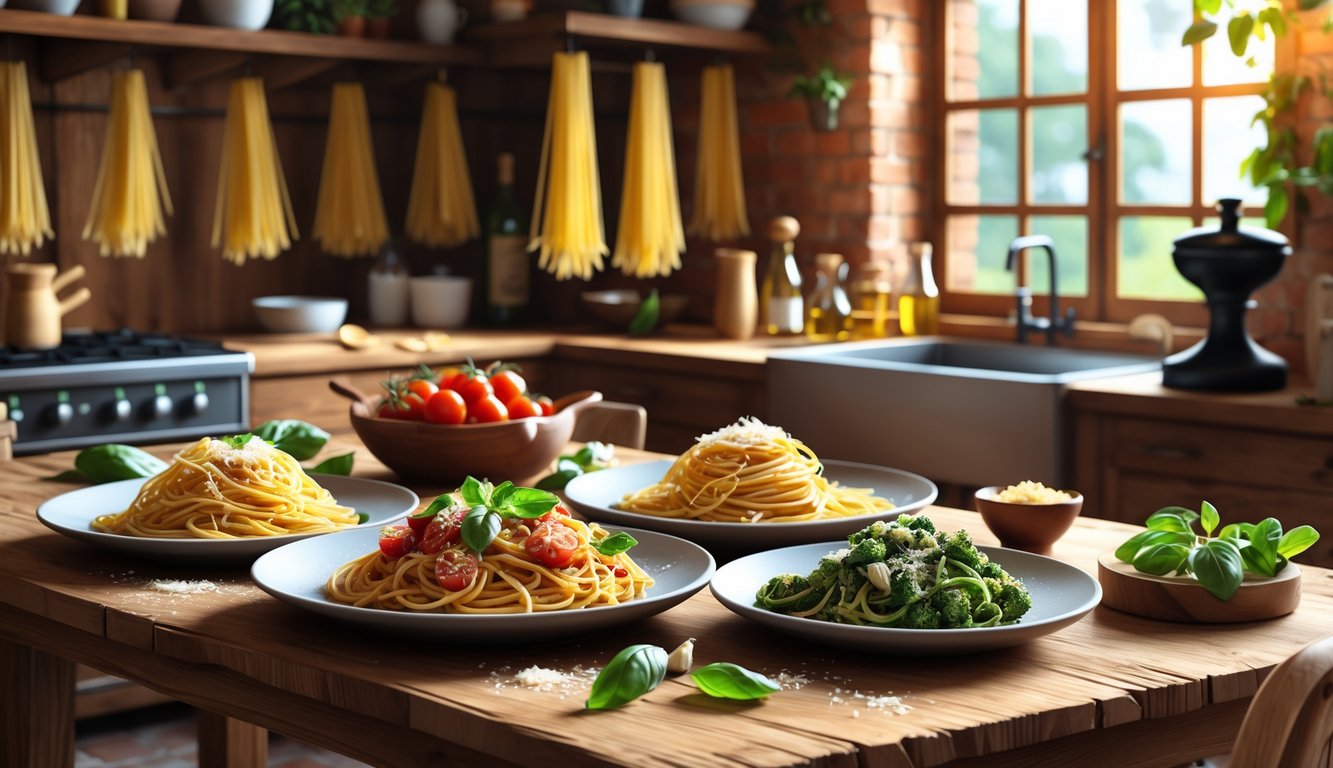
Americanized Italian Dishes and Their Origins
Sometimes I look at the mountain of melted cheese and weird pasta combos on American menus and just laugh. My family in Naples wouldn’t even recognize half of it. It’s all about adaptation, local ingredients, and, honestly, a little bit of chaos. Nobody’s following some ancient scroll of recipes.
The Story of Chicken Parmesan
Chicken parmesan? Not a thing in Italy. There’s eggplant parmigiana, sure, but chicken? Nope. Total Italian-American invention. Immigrants got here, meat was cheap, everyone wanted protein, and suddenly you’ve got breaded chicken drowning in sauce and cheese. In Naples, they’d serve you cardboard before chicken with spaghetti.
I’ve dodged this dish at family gatherings in New Jersey. Some people love it, but it’s not traditional. Lidia Bastianich once said, “real Italians wouldn’t think to combine breaded meat and pasta on one plate” (Food Network, 2022). Food migration researchers have mapped this all out—see authentic vs. Americanized Italian foods.
Baked Ziti and Its Evolution
Baked ziti? Never saw it in Bologna—at least not the cheesy casserole from New York. Italian immigrants made it work: cheap pasta, ricotta, sauce, whatever cheese was on hand. Ziti’s from the south, but the U.S. version is a whole different beast. It’s about feeding crowds, not tradition.
First time my aunt made it, every tray was different. The American twist isn’t just more cheese, it’s about making do. These pasta casseroles shaped Sunday dinners and restaurant menus for decades (Ladybird Cafe, 2025). It’s more casserole than pasta. If someone calls it “authentic”? I just laugh and pass the garlic bread.
The Real Deal: Melanzane alla Parmigiana
Parmigiana di melanzane (eggplant parmesan) is the real thing. I’ve watched my Nonna fry eggplant, layer it with Parmigiano-Reggiano, and spoon on tomato sauce with scary precision. No chicken, no pasta underneath, no spaghetti on the side. Just eggplant, cheese, tomato, basil. Southern Italian kitchens—Naples, Sicily—own it. Italians argue about olive oil vs. sunflower oil for frying, but nobody adds chicken.
In the U.S., “eggplant parmesan” usually means some baked vegetarian hybrid. In Italy, melanzane alla parmigiana sticks to the basics. The Italian American Page says regional lines matter, but nobody’s making eggplant-and-spaghetti casseroles. No health miracle, just simple food. Sometimes people use zucchini if the eggplants look weird, but then my uncle starts complaining.
Not on the Menu: Italian Pizza and Toppings
Wild how every pizza spot outside Italy thinks tossing on a bunch of toppings makes it “authentic.” I once had a waiter in Paris swear everyone loves Hawaiian pizza—meanwhile, six Italians at my table just stared, horrified. The gap between pizza menus outside Italy and the ingredient-obsessed corners of Rome? Massive. But good luck convincing anyone with a slice of pineapple pizza in hand.
Pineapple on Pizza: A Taboo
I mean, pineapple on pizza—why? Who’s actually asking for this? I’ve seen YouTube “foodies” act like it’s rebellious, but honestly, most Italians just look vaguely offended. I once watched a guy in Naples—actual chef, big mustache—literally recoil when someone said “Hawaiian pizza.” He muttered something about fruit and Margherita, and I’m pretty sure he meant it as an insult. Bruno Barbieri (he’s got Michelin stars, so, you know, not a nobody) even told Gambero Rosso it’s “almost like vandalism.” Not subtle.
Supposedly, 78% of Italians (yeah, Coldiretti did a survey in 2023) are anti-pineapple. Not just “meh”—actively against it. And let’s be real: the sweetness smothers the San Marzano tomatoes and mozzarella di bufala, which is kind of the entire reason you order pizza in Italy. If a place claims pineapple’s “authentic,” maybe double-check if their chef’s ever been within 500 miles of Rome. Magnifico Food’s guide just dumps it straight into the “Italians quietly hate this” pile.
But okay, if you’re the sort of person who swaps espresso for a kiwi-pumpkin latte because “caffeine gives me jitters,” I guess you’ll do what you want. Still doesn’t make sense to me.
Pepperoni Pizza Misconceptions
Want to see an Italian’s eyebrow hit their hairline? Ask for “pepperoni pizza” in Milan. I’ve watched this play out: tourist points at the menu, server brings out a pizza covered in bell peppers (peperoni, not pepperoni), and the customer looks like they just got pranked on hidden camera.
Here’s the thing: “pepperoni pizza” isn’t Italian. It’s American. Italians use salame piccante for spicy stuff, but even that depends on the region. The confusion? It’s just spelling—“peperoni” is bell pepper. The greasy, spicy sausage slices in the U.S.? Not a thing here. Pizzerias literally have to clarify this on English menus so you don’t get a veggie surprise (proof).
Massimo Vitta (writes for La Cucina Italiana) called this the “biggest pizza-diplomacy fail.” He’s not wrong. And if you ever see “pepperoni” next to mozzarella and prosciutto on a real Italian menu? I’d bet the chef’s already halfway out the door.
Italian Classics: Pizza alla Diavola
So, you want spicy? You order pizza alla diavola. Never “pepperoni.” No one with a working palate would call it that. It’s got salame piccante, maybe some fire-roasted chili oil, super thin crust—no puddles of orange grease. Tried it in Florence once; the place bragged their nonna’s salami wouldn’t ruin your shirt. Bonus points for olives or chili flakes.
They keep it simple, too. No overloaded mess—just dough, spicy sausage, good cheese. Ask for extra cheese and you’ll get a death glare, but the next table’s ordering a mushroom-only pizza and nobody cares. Traditions are weird like that.
Want to see what Italians actually put on pizza? Magnifico Food lays it all out. Spoiler: pineapple’s not making the cut.
Dining Out in Italy: Tips for Tourists
Some meals in Italy haunt me. I’m talking limp spaghetti, “spaghetti bolognese” that’d make a grandma cry, and menus so cliché you can practically smell the printer ink. If you stick to the English menus or those big, shiny trattorias on the main piazzas, you’re missing the actual chaos and magic of Italian food. It’s just not the same as those travel ads with the golden sunsets and happy couples.
Spotting Tourist Trap Dishes
Honestly, I lost track of how many dinners I wasted staring at “Pasta Alfredo” and weird international mashups. If the menu’s sticky, has burgers, sushi, and milkshakes on it, and the waiter’s got a stack of laminated sheets, I’m out. Real Italian food? It’s fiercely regional.
Menus with food photos? Or ones in six languages? Nope. The Italian National Institute of Statistics said 58 million tourists hit Italy last year, and these places are built for them. Locals don’t even look up. If someone’s yelling in English to get you inside, I’m already halfway down the street. “Menu Turistico”? Hard pass. Italians would rather eat at home than fall into that trap.
Understanding Italian Dining Culture
I once sat for half an hour before anyone even took my order, and no one cared. Meals here are slow. Nobody’s rushing. It’s about talking, people-watching, eating—sometimes in that order. Plates show up when they show up. If you’re the only one tapping your fork, congrats, you’re the tourist.
Breakfast? Forget eggs and bacon. Italians eat a tiny pastry, maybe a cornetto, with espresso. That’s it. (If you want the full rundown, try this Italian breakfast guide). Pasta isn’t meant to be hacked up; you swirl it. Lunch is a marathon, not a sprint—whole families, kids, everyone. I still can’t do three hours of small talk, but I try because, apparently, that’s how it works.
What to Order for Authentic Flavors
If I see fettuccine alfredo on the menu, I’m already suspicious. Go local. In Naples, get the margherita. Rome? Cacio e pepe, amatriciana, carbonara (not the creamy abomination). “Spaghetti and meatballs”? Only in American movies.
My move? Find the shortest menu possible—three or four pastas, zero nonsense, maybe a fish dish. House wine, always. Ignore the “global” favorites (no penne arrabbiata in Venice, please), and check the chalkboard for specials. Seriously, try the pasta and pizza. They’re not just for tourists. Every bite tastes like the place you’re in (see more real advice here). Sometimes a dish shows up and it’s not what I expected—like, why does the squid ink taste like burnt rubber?—but hey, that’s part of the fun.



